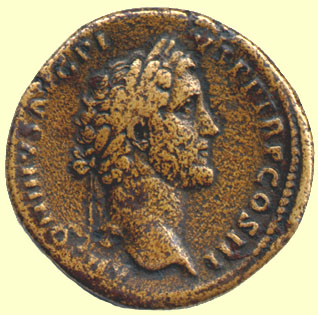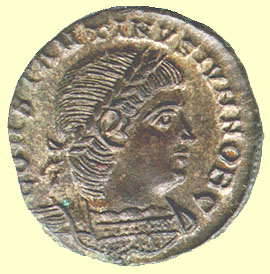 Contents -
Previous Article -
Next Article
Contents -
Previous Article -
Next Article
Portraits of the Emperor and His Family
Since there was only a limited area on the coin in which a message could be displayed, a highly effective system of letting images and symbols stand for ideas developed. Actually, this system did not begin with coins. For centuries, peoples of the ancient Mediterranean had been using pictures to stand for religious and other ideas. It was developed to a high degree through its use on coins, though. The visual symbol would be coupled with a written inscription to allow the coin to actually convey more than one message at a time.
 Most of the symbolism on the obverse side of the coin contained a standard portrait of the emperor or noblewoman in whose name the piece was struck. Sometimes the children of emperors or even a very powerful and popular general such as Marcus Agrippa would have their portraits on a coin. Along with the image of the personality there would be an inscription containing his or her name and other important information such as how many times he had been consul or held the office of Tribune. Other titles and honors were displayed. These included "Chief Priest" (PONTIFEX MAXIMVS or an abbreviation), "Father of his Country" (PATER PATRIAE), and "Our Lord" (DOMINI NOSTER or simply DN). The style of the portrait throughout the years carried its own message.
Most of the symbolism on the obverse side of the coin contained a standard portrait of the emperor or noblewoman in whose name the piece was struck. Sometimes the children of emperors or even a very powerful and popular general such as Marcus Agrippa would have their portraits on a coin. Along with the image of the personality there would be an inscription containing his or her name and other important information such as how many times he had been consul or held the office of Tribune. Other titles and honors were displayed. These included "Chief Priest" (PONTIFEX MAXIMVS or an abbreviation), "Father of his Country" (PATER PATRIAE), and "Our Lord" (DOMINI NOSTER or simply DN). The style of the portrait throughout the years carried its own message.  A portrait of an emperor wearing a beard might indicate that he considered himself a philosopher like the old Greek stoics (Marcus Aurelius) or might indicate that he had sided with the pagans against the Christians (Julian II). The portraits of the Tetrarchs (Diocletian, Constantius I, Galerius, and Maximianus) and their caesars almost all had great, massive necks and powerful, jutting jaws. Their rough, stern, no-nonsense portraits also featured a wrinkled forehead and a closely cropped military beard. The message to the citizens of the empire was "When you look at one of us, you are looking at all four of us. We stand together, the four of us united. We’re tough, don’t cross us. We govern with sternness to meet the needs of these unsettled times."
A portrait of an emperor wearing a beard might indicate that he considered himself a philosopher like the old Greek stoics (Marcus Aurelius) or might indicate that he had sided with the pagans against the Christians (Julian II). The portraits of the Tetrarchs (Diocletian, Constantius I, Galerius, and Maximianus) and their caesars almost all had great, massive necks and powerful, jutting jaws. Their rough, stern, no-nonsense portraits also featured a wrinkled forehead and a closely cropped military beard. The message to the citizens of the empire was "When you look at one of us, you are looking at all four of us. We stand together, the four of us united. We’re tough, don’t cross us. We govern with sternness to meet the needs of these unsettled times."
The reverse of this beautiful AE4 bearing Constantine II's portrait may be seen on the page explaining the vexilla or Roman battle standard.
Today, we might have a formal portrait or photograph to show is a likeness of a mother, father, aunt, grandfather, or other family member. Wedding photos, School pictures, drivers’ license mug shots, and other "official" photos serve this purpose. Likewise, each emperor had an official likeness in the form of a bust that was copied and sent to the mints throughout the empire. Using these, the artisan who prepared the coinage dies could create an official portrait of the ruler to be struck onto the coinage produced in his name. In this way, everyone in the Roman Empire could see what their emperor looked like. Sometimes, especially if he enjoyed a long reign, there might be several official likenesses used during different periods of time. Young and mature portraits are known for Hadrian and other rulers. The portraits of Faustina the Younger and Julia Domna range from young, girlish portraits to images of old women. These series are especially popular with collectors.
Go to next article: A Fascinating and Affordable Hobby
Go back to previous article: A Gallery of Reverse Images and What They Symbolize
Return to Roman Coins Table of Contents
 Most of the symbolism on the obverse side of the coin contained a standard portrait of the emperor or noblewoman in whose name the piece was struck. Sometimes the children of emperors or even a very powerful and popular general such as Marcus Agrippa would have their portraits on a coin. Along with the image of the personality there would be an inscription containing his or her name and other important information such as how many times he had been consul or held the office of Tribune. Other titles and honors were displayed. These included "Chief Priest" (PONTIFEX MAXIMVS or an abbreviation), "Father of his Country" (PATER PATRIAE), and "Our Lord" (DOMINI NOSTER or simply DN). The style of the portrait throughout the years carried its own message.
Most of the symbolism on the obverse side of the coin contained a standard portrait of the emperor or noblewoman in whose name the piece was struck. Sometimes the children of emperors or even a very powerful and popular general such as Marcus Agrippa would have their portraits on a coin. Along with the image of the personality there would be an inscription containing his or her name and other important information such as how many times he had been consul or held the office of Tribune. Other titles and honors were displayed. These included "Chief Priest" (PONTIFEX MAXIMVS or an abbreviation), "Father of his Country" (PATER PATRIAE), and "Our Lord" (DOMINI NOSTER or simply DN). The style of the portrait throughout the years carried its own message.  A portrait of an emperor wearing a beard might indicate that he considered himself a philosopher like the old Greek stoics (Marcus Aurelius) or might indicate that he had sided with the pagans against the Christians (Julian II). The portraits of the Tetrarchs (Diocletian, Constantius I, Galerius, and Maximianus) and their caesars almost all had great, massive necks and powerful, jutting jaws. Their rough, stern, no-nonsense portraits also featured a wrinkled forehead and a closely cropped military beard. The message to the citizens of the empire was "When you look at one of us, you are looking at all four of us. We stand together, the four of us united. We’re tough, don’t cross us. We govern with sternness to meet the needs of these unsettled times."
A portrait of an emperor wearing a beard might indicate that he considered himself a philosopher like the old Greek stoics (Marcus Aurelius) or might indicate that he had sided with the pagans against the Christians (Julian II). The portraits of the Tetrarchs (Diocletian, Constantius I, Galerius, and Maximianus) and their caesars almost all had great, massive necks and powerful, jutting jaws. Their rough, stern, no-nonsense portraits also featured a wrinkled forehead and a closely cropped military beard. The message to the citizens of the empire was "When you look at one of us, you are looking at all four of us. We stand together, the four of us united. We’re tough, don’t cross us. We govern with sternness to meet the needs of these unsettled times."
 Contents -
Previous Article -
Next Article
Contents -
Previous Article -
Next Article